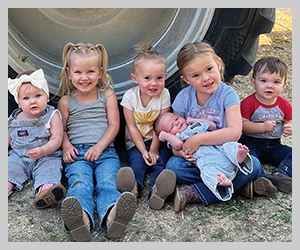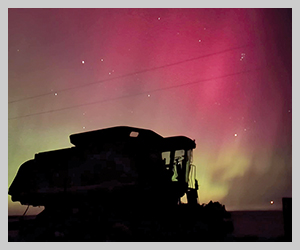
Down in the Horse Heaven Hills, Garrett Moon and his wife, Jessica, have begun selling small grains to regional flour mills and directly to consumers in an effort to look beyond the commodity market.
“I think part of it was a little bit of curiosity to break outside of the commodity mold and see if we could realize some higher value,” Garrett said. “We have a conservation mindset on our farm, trying to care for the ground and the soils. If you just sell on the commodity market and you do those extra mile things, you don’t necessarily get paid for that. This is an effort to maybe find buyers who would recognize the extra things we are doing.”
The Moons began experimenting with local sales in 2017. Approximately 20 to 30 percent of what they grow is earmarked for the local and regional food system; the rest of their grain will be sold on the commodity market. On their website — moonfamilyfarm.com — they offer several varieties of wheat, triticale and spelt for sale. They have also partnered with Ethos Stone Mill in the Tri-Cities and Cairnspring Mills in the Skagit Valley to sell flour made from their grain.
Another reason the Moons have moved into this space is they enjoy connecting with end-users of their crops.
“Most of the time, when you are a commodity farmer, you put your crop on the truck, it leaves the farm, and that’s the end of story,” Garrett said. “You don’t know where it goes. You don’t know who eats it. You don’t know anything about it. You don’t think of varieties of grain in anything other than the agronomics of what they do, so it’s fascinating to get feedback directly from bakers on what they like about specific varieties. They’ll try two or three varieties that I’m growing, and they’ll tell me they like the flavor of this one better. It’s almost like dealing with beer and wine, and it’s cool to see how they take the thing and run with it.”
One of the challenges the Moons had to face as they explored this new market was educating buyers and consumers on how farms actually work by being open about the way their grain is grown. Garrett pointed out that consumers can be particularly skeptical about chemicals, but because he uses no-till methods, he has to rely on herbicides to manage weeds. He’s found that he’s had to be very open to talking about the way he farms and why he does what he does.
“It’s an educational process,” he explained. “I think, coming from farm background, we haven’t always welcomed those conversations. We’ve been cautious about them, but we need to have them to build trust with buyers and consumers.”
Another challenge the Moons have dealt with is how quickly food fads come and go. The Horse Heaven Hills gets an average of 9 to 10 inches of moisture a year, so a grower may need one or two years to produce a crop, and even longer if they need to do seed increases first.
“You have to be cautious about what you are willing to take on. You have to educate your buyers as well. Many times, they just don’t understand the limitations of farming in general and farming in Horse Heaven in particular. I can’t just throw whatever they bring me in the ground and expect it to even survive, let alone yield,” Garrett said.
Overall, Garrett said moving into the local and regional food system has been enjoyable and worked well for their farm. Up to now, he feels grain has been overlooked by consumers focused on food miles and sustainability, even at restaurants and markets where that is their focus.
“You’d go in (to a restaurant) and they would tell you where everything on the menu came from, but when it came to wheat, it was just whatever came off the Sysco truck,” he said. “We happened to stumble into a good time and place where the food world was open to this and was curious about it and wanting to move in this direction.”












